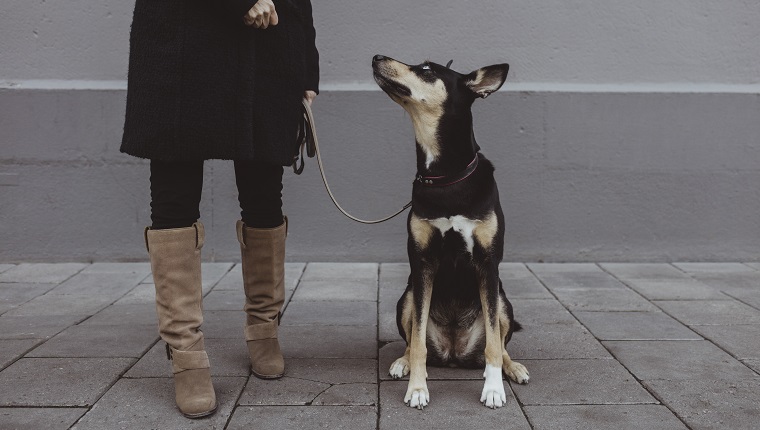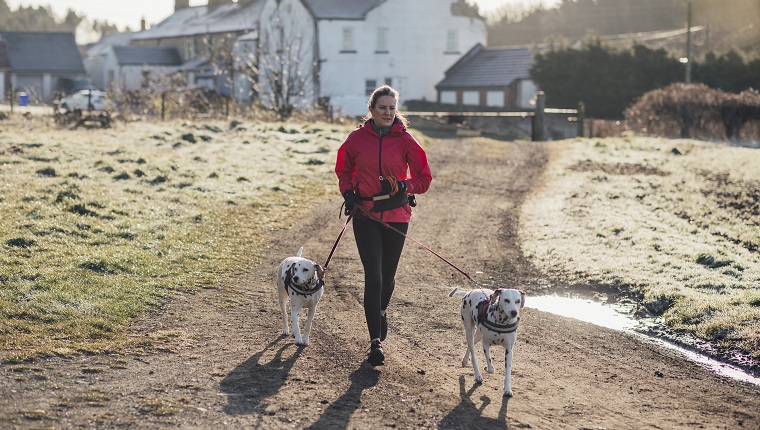Congratulations on taking up running with your dog! Canicross, as it’s known to lovers of the sport, is a great activity for dogs of all sizes, from little Jack Russell Terriers to larger breeds such as German Shepherds and Labradors.
One of the most important considerations when you decide to take up running with your dog is safety, not just for you but for your canine too. Doing some training to ensure your dog understands basic cues will be essential for both of your safety.
Here are a few tips for training your dog to jog with you safely, along with the five most basic canicross cues, why you may need them, and how to teach them to your dog.
Safety First: Make Sure You Have The Right Equipment
When jogging with your dog, it’s crucial that you’re all wearing the right equipment. You wouldn’t go for a long run without your sports kit, and the same is true of your dog.
Your dog needs a correctly fitting sport harness, ideally one that is designed for running and therefore will not restrict their movement. It’s important that you do not run with your dog in a collar or head halter, as this can put unnecessary pressure on the dog’s face and neck and cause injuries.
If you’re running in an area where your dog could potentially injure their paws, such as a trail with sharp rocks, you may also wish to condition your dog to running in shoes, too.
Certain breeds like Labradors and Labrador mixes have webbed paws. For breeds with webbed paws, paw protection is especially important to prevent cuts and injuries.
Cue #1: Movement

Teach a cue to encourage your dog to pull into their harness, especially if you’ve done training work on loose lead walking previously.
If your dog is motivated by toys, one fun way to do this is to put your running kit on and practice in the yard. Stand at one end of the yard with your dog and throw a toy for them. As they pull into their harness to chase the toy, you can use your cue — for example, “let’s go” — to pair the word with pulling into the harness.
You can also accomplish this by having a person call your dog from the other end of the yard. Then, in the same way as you would with the toy, use your cue word as your dog pulls into the harness to make the connection.
Cue #2: Left & Right
This is one of the most crucial safety cues because you’ll need to be able to direct your dog while you’re out running.
One of the most popular ways to teach this cue is to start by running with an already experienced dog. A green dog will instinctively follow an experienced dog and handler. So as they turn, you can start to say “right” or “left” depending on the direction.
Another way to solidify the foundation of this behavior is to practice in your home or garden. Stand with your dog in front of you as if you were on a jogging trail. You can then throw little treats out to the side, saying the direction before you throw.
In time, your dog will then begin to predict the direction the treat will go based on your cue and move in that way. Eventually, the joy of getting to continue running will be your reinforcer, and food will no longer be required.
Cue #3: With Me

This command is useful for when you reach the top of a hill, as you don’t want your dog running out front and potentially pulling you over! Though it can be a challenging cue to teach, it’s essential for both yours and your dog’s safety.
To start teaching this command, have your dog alongside you, and reward in place. You ideally want to practice this command first while stationary, building up to walking and then jogging.
If you want your dog to head out front again, you can use your movement command as a release cue.
Cue #4: Stop!
After going on your run, it’s a safety essential that your dog is able to stop. This is an especially important cue because, if you are running around trails next to roads with your dog five to seven feet in front of you, they could easily run into the roads.
A great way to teach this cue is using a method known as errorless learning. First, you’d need a large area, such as your yard, and a broom or anything else that can function as a barrier. To start, throw a treat away from your dog, and mark them — say “yes” or use your clicker — as they reach the broom.
After repeating this several times, you can start to add the word “stop” just before your dog reaches the broom. Eventually, you can remove the broom and simply use your cue, before generalizing your cue to your jogging equipment.
If your dog struggles in understanding the cue between circumstances, you can take your training back a stage by having your dog in a harness and running towards the broom while they’re attached to you.
As you approach, you can use your stop cue and throw a treat over to them.
Cue #5: Leave

Teaching your dog when they can and cannot interact with dogs and people or chase other animals on the trail will be another important cue. You don’t want your dog suddenly darting off into the forest and taking you with them!
Having a solid “leave” cue generally will help with this. One brilliant way to teach this is using another errorless learning method, though this methodology was developed by the Glasgow Dog Trainer.
He starts with nothing to leave, marking the dog for simply remaining still with nothing in his hand. He then adds treats, the idea being that the dog already knows that they do not have to do anything but remain away from the food to be rewarded.
You can then work up to leaving treats on the floor and running past them with your before generalizing this to running past dogs, other runners, or even wildlife!
Final Top Tip: What To Do After A Run
Though it may seem self-explanatory, there are some important safety precautions you must take after running with your dog. First of all, you must always make sure your dog is offered fresh water after exercise, especially if you’ve been unable to do so while running.
Secondly, you must always check over your dog’s paw pads for injury. Many dogs enjoy running with their humans so much they’ll continue to run, even while hurt! It is, therefore, an absolute necessity to check your dog over as soon as you can and to get them medical treatment if they need it.
It’s also important to note that smooth paw pads are not a good sign either. This indicates that your dog has run so far that they’ve filed their pads down!
Finally, nutrition is crucial, especially if you’re running large distances regularly. A dog who’s taken out for runs three times a week or more will need a much higher percentage of fat in their diet than a standard dog, around 16 percent on average! So make sure that your dog eats a good meal both several hours before a run, but also after a run to replace burned calories.
Does your dog know all of these commands to run with you safely? Do you have any other tips for jogging with your dog? Let us know in the comments below!









